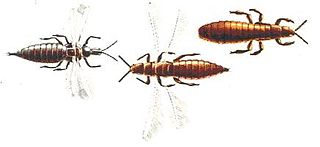
Thrips are minute, slender insects with fringed wings and unique asymmetrical mouthparts. Entomologists have described approximately 6,000 species. They fly only weakly and their feathery wings are unsuitable for conventional flight; instead, thrips exploit an unusual mechanism, clap and fling, to create lift using an unsteady circulation pattern with transient vortices near the wings.
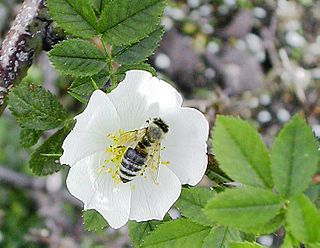
Neoptera is a classification group that includes most orders of the winged insects, specifically those that can flex their wings over their abdomens. This is in contrast with the more basal orders of winged insects, which are unable to flex their wings in this way.
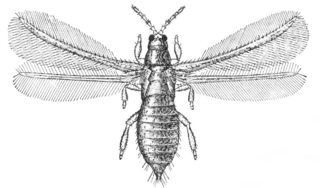
The Thripidae are the most speciose family of thrips, with over 290 genera representing just over two thousand species. They can be distinguished from other thrips by a saw-like ovipositor curving downwards, narrow wings with two veins, and antennae of six to ten antennomeres with stiletto-like forked sense cones on antennal segments III and IV.

The Aeolothripidae are a family of thrips. They are particularly common in the holarctic region, although several occur in the drier parts of the subtropics, including dozens in Australia. Adults and larvae are usually found in flowers, but they pupate on the ground. While they normally prey on other arthropods, many feed also on flowers.

Orthotospovirus is a genus of negative-strand RNA viruses, in the family Tospoviridae of the order Bunyavirales, which infects plants. Tospoviruses take their name from the species Tomato spotted wilt orthotospovirus (TSWV) which was discovered in Australia in 1919. TSWV remained the only known member of the family until the early 1990s when genetic characterisation of plant viruses became more common. There are now at least twenty species in the genus with more being discovered on a regular basis. Member viruses infect over eight hundred plant species from 82 different families.

The chilli thrips or yellow tea thrips, Scirtothrips dorsalis Hood, is an extremely successful invasive species of pest-thrips which has expanded rapidly from Asia over the last twenty years, and is gradually achieving a global distribution. It has most recently been reported in St. Vincent (2004) Florida (2005), Texas (2006), and Puerto Rico (2007). It is a pest of economic significance with a broad host range, with prominent pest reports on crops including pepper, eggplant, mango, citrus, strawberry, grapes, cotton, tea, peanuts, blueberry, and roses. Chilli thrips appear to feed preferentially on new growth, and infested plants usually develop characteristic wrinkled leaves, with distinctive brown scarring along the veins of leaves, the buds of flowers, and the calyx of fruit. Feeding damage can reduce the sale value of crops produced, and in sufficient numbers, kill plants already aggravated by environmental stress. This thrips has also been implicated in the transmission of three tospoviruses, but there is some controversy over its efficiency as a vector.

Paraneoptera or Acercaria is a superorder of insects which includes lice, thrips, and hemipterans, the true bugs. It also includes the extinct order Permopsocida, known from fossils dating from the Early Permian to the mid-Cretaceous.
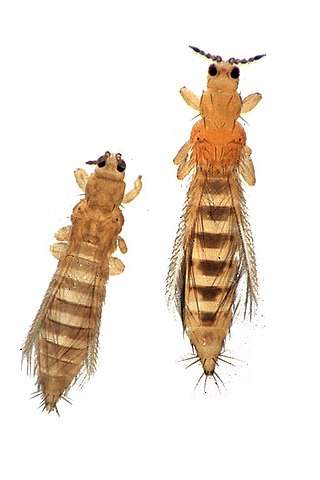
The Thripinae are a subfamily of thrips, insects of the order Thysanoptera. The Thripinae belong to the common thrips family Thripidae and include around 1,400 species in 150 genera. A 2012 molecular phylogeny found that the Thripinae was paraphyletic; further work will be needed to clarify the relationships within the group.
Thrips paradoxa is a species of common thrip in the family Thripidae.
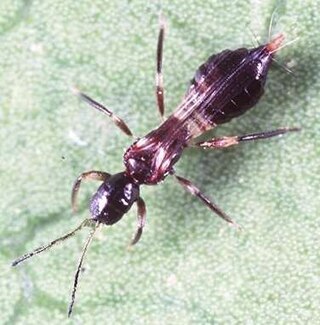
Terebrantia is a suborder of thrips. Order Thysanoptera includes 5,500 species classified into two suborders distinguished by the ovipositor. Terebrantia have a well-developed conical ovipositor, while the Tubulifera do not. It contains 13 families, five of which are only known from fossils. Members of Terebrantia mainly feed on plants. All have two larval instars followed by two pupal instars.
Ctenothrips is a genus of thrips in the family Thripidae. There are about 10 described species in Ctenothrips.
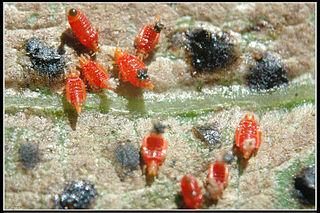
Panchaetothripinae is a subfamily of thrips in the family Thripidae, first described in 1912 by Richard Siddoway Bagnall. There are about 11 genera and more than 50 described species in Panchaetothripinae.
Parthenothrips is a genus of thrips in the family Thripidae. There is one described species in Parthenothrips, P. dracaenae.
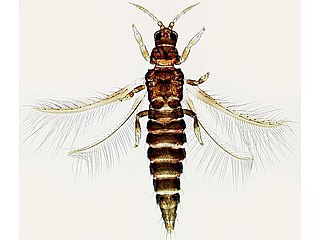
Echinothrips americanus is a species of thrips in the family Thripidae. It is found in North America, Europe, and Asia. E. americanus was first described in 1913 by entomologist A.C. Morgan in Quincy, Florida, where he found the insect on a Veratrum viride plant. Suggested common names include Poinsettia thrips and Impatiens thrips. Since their spread throughout Europe as early as 1995, and subsequently China, E. americanus has been called an "upcoming pest."

Aeolothrips is a genus of predatory thrips in the family Aeolothripidae. There are more than 80 described species in Aeolothrips.
Merothripidae is a family of thrips in the order Thysanoptera. There are at least 4 genera and 20 described species in Merothripidae.
Heterothripidae is a family of thrips in the order Thysanoptera. There are about 6 genera and at least 70 described species in Heterothripidae.
Brakothrips is a genus of thrips in the family Phlaeothripidae, first described by Crespi, Morris and Mound in 2004. The type species is Brakothrips gillesi. Insects in this genus are found only in Australia, living under the splitting bark of young branches of Acacias.
Archescytinidae is an extinct family of fungus-feeding thrips belonging to the order Thysanoptera that was first defined by Robert John Tillyard in 1926. They are the oldest known thrips family and they existed between the Asselian epoch of the Early Permian and the Toarcian epoch of the Early Jurassic.

Condylognatha or Panhemiptera is a monophyletic grouping (superorder) that contains Hemiptera and Thysanoptera (thrips). Condylognatha belongs to Paraneoptera, which include its sister group, lice (Psocodea).












